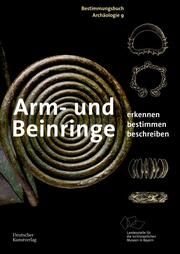Arm- und Beinringe
416 Seiten, 439 s/w Illustr., 56 farbige Illustr., 439 b/w and 56 col. ill.
Lieferzeit: 5 Werktage(inkl . Versand)
Arm-rings are among the most common items of jewellery. From the earliest times, they have appeared in various shapes and materials. The wearing of leg-rings was limited to the Bronze and Iron Ages. Together with spiral rings and mountings, arm- and leg-rings form an essential aspect of our archaeological legacy. They not only decorated the body but also accumulated value. This volume offers a comprehensive, systematic guide to the object groups. Typical forms are presented, described, and illustrated in a study of jewellery in German-speaking countries from the Palaeolithic era to the Middle Ages. This reference work is aimed at any interested reader but also provides a practical tool for recording and indexing museum and archaeological collections. - First comprehensive systematics of pre- and early historical arm and leg ornaments Suitable for academics as well as interested amateurs
Angelika Abegg-Wigg studied prehistory and early history, classical archaeology, art history, and book and library studies in Erlangen and Kiel. She received her doctorate in 1992 with a thesis on Roman burial mounds in the Middle Rhine, Moselle and Saar regions. After working at various scientific institutions in Germany, she has been working at the Museum für Archäologie Schloss Gottorf in Schleswig since 2003, where she is the curator responsible for the Iron Age. Ronald Heynowski has been working at the Saxon State Office for Archaeology in Dresden for more than 25 years. His responsibilities include site inventory and the scientific archive. He studied pre- and early history, ethnology and anthropology in Mainz and Kiel. His PhD thesis was dedicated to the Iron Age costume jewelry of Central Germany, his habilitation thesis deals with a specific neck ring form of the Bronze and Iron Age.
| Autor | Heynowski, Ronald/Abegg-Wigg, Angelika |
|---|---|
| Verlag | Deutscher Kunstverlag GmbH |
| ISBN | 9783422801387 |
| ISBN/EAN | 9783422801387 |
| Lieferzeit | 5 Werktage(inkl . Versand) |
| Erscheinungsdatum | 26.05.2023 |
| Lieferbarkeitsdatum | 31.12.2023 |
| Einband | Kartoniert |
| Format | 2.6 x 24 x 17.2 |
| Seitenzahl | 416 S., 439 s/w Illustr., 56 farbige Illustr., 439 b/w and 56 col. ill. |
| Gewicht | 1159 |
Weitere Informationen
| Verlag | Deutscher Kunstverlag GmbH |
|---|---|
| ISBN | 9783422801387 |
| Erscheinungsdatum | 26.05.2023 |
| Einband | Kartoniert |
| Format | 2.6 x 24 x 17.2 |
| Gewicht | 1159 |
Arm-rings are among the most common items of jewellery. From the earliest times, they have appeared in various shapes and materials. The wearing of leg-rings was limited to the Bronze and Iron Ages. Together with spiral rings and mountings, arm- and leg-rings form an essential aspect of our archaeological legacy. They not only decorated the body but also accumulated value. This volume offers a comprehensive, systematic guide to the object groups. Typical forms are presented, described, and illustrated in a study of jewellery in German-speaking countries from the Palaeolithic era to the Middle Ages. This reference work is aimed at any interested reader but also provides a practical tool for recording and indexing museum and archaeological collections. - First comprehensive systematics of pre- and early historical arm and leg ornaments Suitable for academics as well as interested amateurs
Angelika Abegg-Wigg studied prehistory and early history, classical archaeology, art history, and book and library studies in Erlangen and Kiel. She received her doctorate in 1992 with a thesis on Roman burial mounds in the Middle Rhine, Moselle and Saar regions. After working at various scientific institutions in Germany, she has been working at the Museum für Archäologie Schloss Gottorf in Schleswig since 2003, where she is the curator responsible for the Iron Age. Ronald Heynowski has been working at the Saxon State Office for Archaeology in Dresden for more than 25 years. His responsibilities include site inventory and the scientific archive. He studied pre- and early history, ethnology and anthropology in Mainz and Kiel. His PhD thesis was dedicated to the Iron Age costume jewelry of Central Germany, his habilitation thesis deals with a specific neck ring form of the Bronze and Iron Age.
Kategorie

